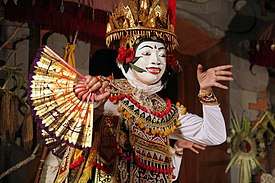Sisingaan
Sisingaan or Gotong Singa is a form of Sundanese dance that has special meaning when European colonialists colonized the Subang area, in West Java, Indonesia. At that time, after the enactment of the Agrarian Law in 1870, the Dutch colonial government opened wide opportunities for the expansion of the business of investors from Europe to take as much as possible agricultural products and industrial raw materials from the archipelago. The city of Subang, which has a portion of the highland topography and is suitable for plantation areas, is the target of foreign investors.[1]
.jpg) | |
| Native name | Tari Sisingaan |
|---|---|
| Origin | Indonesia |
Sisingaan dance cannot be separated from the symbol of a lion doll that children usually ride in their performances. Historically, sisingaan was a symbol of the hatred of Subang citizens towards plantation capitalists from the Netherlands and Britain who received protection from the colonial government.
Today, the art of sisingaan more interpreted as part of public entertainment. Sisingaan art is generally staged by going around the village when there are community events such as circumcision, the inauguration of village officials, weddings and so on.[2][3]
History
Sisingaan was created around 1840 by artists from the Ciherang area, which is about 5 km from downtown Subang. At that time, the capitalists from England founded a private plantation company called P & T Lands (Pamanoekan en Tjiasemlanden). This company holds the plantation exploitation rights in the Subang region. This situation is a consequence of the economic liberalization policy carried out by the Dutch government after 1870, which in fact continued until Indonesia's independence today. This sisingaan art can be categorized as a symbolic resistance of the people of Subang against the invaders. The lion, is a symbol of the Netherlands and the United Kingdom, two countries which were seen as invaders by the people of Subang in the mid-19th century. This means ridicule and harassment of the pride of the colonialist symbol. Thus the meaning is still an interpretation of the lingering symbol among Subang residents until now. The symbol of a lion doll that is occupied by a small child can be interpreted as a reflection of the culture of anti-colonialism in Subang society.
Performance
.jpg)
The performance begins with giving a speech by the leader of the sisingaan group. After the opening remarks, the child will be circumcised, the bride or public figure will be paraded on a lion doll. Then, accompanied by the rhythm of songs from the art of Ketuk Tilu and Doger, 8 players from the sisingaan group will start carrying two stuffed lions that have been mounted by humans. Sisingaan art begins with a tour around the village or village, until finally returning to its original place. The show ends with the arrival of the group on the spot when the beginning of the show begins.
In the past, the majority of the players were 8 adult men who played lion dolls (1 doll carried by 4 people), accompanied by a group leader, several waditra players (traditional musical instruments), and one to two people jajangkungan (players who use wood as long as 3-4 meters when walking in the middle of the show). However, now there are many sisingaan groups consisting of female players, especially for the position of a lion doll cutter.
See also
- Barong (mythology)
- Reog
- Sundanese dance
- Dance of Indonesia
References
- "Sisingaan Sindiran ala orang Sunda". Indonesia.go.id (in Indonesian). Retrieved 2020-07-15.
- "Perkembangan Sisingaan". kotasubang.com (in Indonesian). Retrieved 2020-07-15.
- "Sisingaan Adalah Cara Berontak orang Sunda Terhadap Penjajah". jabarnews.com (in Indonesian). Retrieved 2020-07-15.
